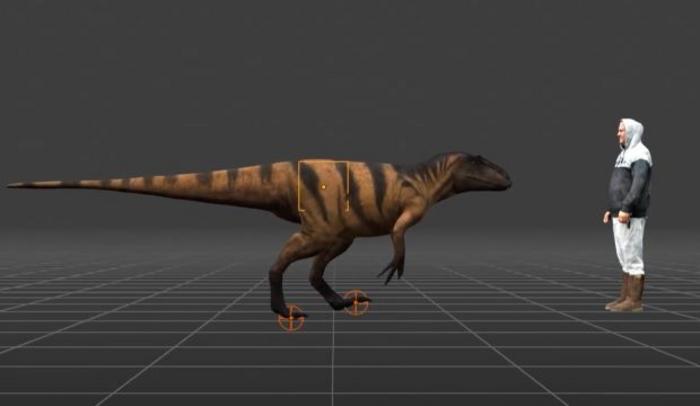Scientists have reconstructed the walking pattern of a massive prehistoric predator by digitally analyzing the longest dinosaur trackway in East Asia.
A research team led by the University of Queensland has transformed 80 consecutive footprints spanning nearly 70 meters into a revealing animation that shows precisely how this ancient creature moved through the landscape 120 million years ago. Using advanced digital modeling techniques, the researchers determined the dinosaur’s height, weight, and walking speed—revealing not just what the animal looked like, but how it moved through its environment in real-time.
The study, published in Geosciences, demonstrates how digital technology is revolutionizing paleontology by unlocking behavioral information previously impossible to extract from traditional fossil analysis.
The trackway, known locally as the “Phoenix Trackway” in China’s Sichuan Province, preserves a 40-second journey of a two-legged predatory dinosaur that has fascinated both locals and scientists for generations. Once attributed to a mythical phoenix in local folklore, these footprints now tell a scientific story of prehistoric life in motion.
Bringing Ancient Footsteps to Digital Life
Dr. Anthony Romilio from the University of Queensland’s Dinosaur Lab led the digital investigation, using techniques that go beyond what would be possible with traditional field methods. Rather than struggling with the logistics of measuring 80 footprints across 70 meters of rock in the field, the team employed digital modeling to capture and analyze every step with unprecedented precision.
“For the first time this dinosaur’s movements have been reconstructed step by step, revealing how it walked, changed pace and responded to its environment,” Dr. Romilio said. “This sequence of 80 consecutive footprints extends for 70 metres in Sichuan Province, China and is a fleeting moment frozen in stone.”
The analysis revealed the dinosaur was walking at a consistent pace of about 5.3 kilometers per hour—equivalent to a brisk human walk—with brief moments of acceleration to a light trot before returning to its regular pace. More surprisingly, the creature maintained an almost perfectly straight trajectory throughout its journey.
“This wasn’t just a dinosaur wandering aimlessly, it was moving with purpose in a nearly perfectly straight line,” Dr. Romilio noted.
The Animal Behind the Tracks
By calculating the relationship between footprint size and body dimensions, the researchers determined this was a substantial predator, standing about 1.13 meters tall at the hip and weighing up to 292 kilograms. The animal shared similar proportions with Yutyrannus, a feathered dinosaur known from northeastern China during the same early Cretaceous period.
The trackway analysis provided biometric details including:
- Walking speed of 5.3 kilometers per hour (average)
- Body weight of approximately 292 kilograms
- Hip height of 1.13 meters
- Total journey time of about 40 seconds
- Consistently southward trajectory with minimal deviation
The research team, which included Dr. Lida Xing from China University of Geosciences in Beijing, created a digital animation that shows how the dinosaur would have moved along the trackway. This visualization recreates the dinosaur’s walking pattern in a scientifically accurate manner, using a bent-legged posture that reflects how these animals actually moved rather than the straight-legged stance often depicted in older reconstructions.
Digital Revolution in Paleontology
The Phoenix Trackway study represents what researchers describe as the “third wave” of paleontological ichnology—the study of fossil tracks and traces. Where earlier approaches relied on direct field measurements and basic documentation, today’s digital techniques allow for complete virtual preservation and analysis of entire tracksites.
“Trackways can reveal behavioural information and stories that fossilised bones alone cannot provide,” Dr. Romilio explained. “But long trackways such as this have historically been understudied due to the logistical difficulties of measuring them in detail in the field.”
Traditional methods for documenting long trackways involved laying acetate sheets over the tracks to trace them—a time-consuming process with limited accuracy. Digital approaches now enable researchers to capture comprehensive data that can be analyzed repeatedly without damaging the original site.
“Our entirely digital approach allows us to capture, interpret and preserve all the measurements and calculations of fossil track sites on computer to provide a glimpse into the dynamic life of an ancient creature,” Dr. Romilio said.
From Local Legend to Scientific Understanding
The trackway has deep cultural significance in the region where it was found. Known locally as “Shifengwo” or “the stone phoenix nests,” the footprints were once believed by villagers to have been left by a phoenix, even mentioned in a local poem from the Late Qing Dynasty period (approximately 1840-1911).
Today, scientific analysis has transformed this cultural artifact into a valuable window into prehistoric behavior. The detailed digital reconstruction not only honors the trackway’s historical significance but enhances our understanding of how these ancient creatures moved through their world.
As digital techniques continue to advance, researchers anticipate even more detailed insights from fossil trackways worldwide. The methods demonstrated in this study could be applied to other long dinosaur trackways that have been documented but not fully analyzed due to their size and complexity. For paleontologists, each preserved footprint sequence represents not just evidence of an animal’s existence, but a moment of its life captured in motion—a record that, with the right digital tools, can bring prehistoric behavior back to life with remarkable clarity.
If our reporting has informed or inspired you, please consider making a donation. Every contribution, no matter the size, empowers us to continue delivering accurate, engaging, and trustworthy science and medical news. Independent journalism requires time, effort, and resources—your support ensures we can keep uncovering the stories that matter most to you.
Join us in making knowledge accessible and impactful. Thank you for standing with us!

